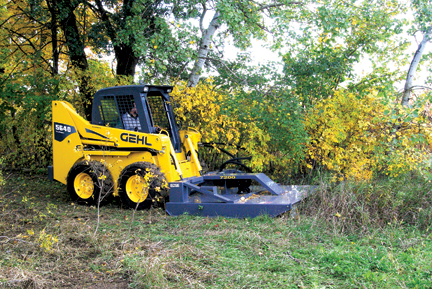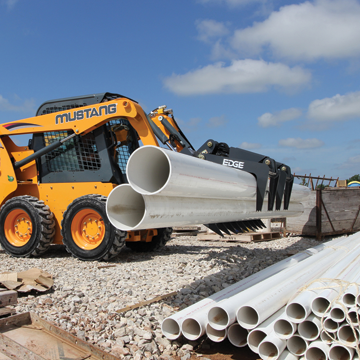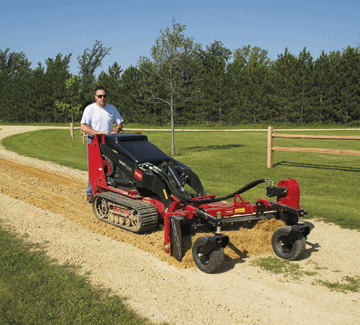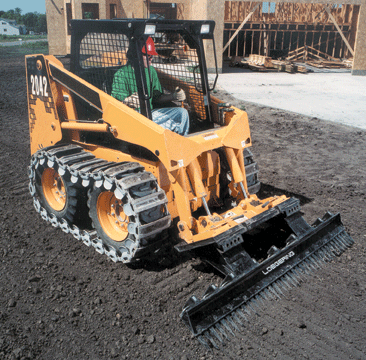Getting Attached: Labor-Saving, Job-Speeding Tools
by Mike Martin
Every day your pro contractor customers try to get more work done, done well, in less time and with less labor. Attachment manufacturers, with their current line, plus product upgrades and new product introductions, do their best to provide the right tool for every task. With the ever-growing list of choices, though, selection can be a bit of a challenge. Knowing what attachments are available, specifics about the carrier being used, and about the project being tackled, puts you in position to help your customers succeed.
It all starts, recognizes Ron Peters, product manager for CEAttachments, by asking a lot of questions. Unless you’re already familiar with the type of project a contractor has on hand, get details on what is being moved, loaded, cleaned, removed, planted or mowed so you’ll know the range of attachments, or attachment, they’ll need. Then, carefully match the attachment to the equipment rented with it, or to the equipment your customers already own. “If the equipment has a hydraulic flow rating that is too low or too high for the attachment being used, they’ll likely run into problems,” Peters says. Worst case, equipment is damaged. At the very least, there’s risk a project takes longer or isn’t done as well as it needs to be.
 |
|
The right attachment can help your customers make site-clearing more productive. CEAttachments has rotary brush mowers in 60- to 90-in. widths, standard and high-flow hydraulics, to match to the task. |
CEAttachments is part of Manitou Americas, including EDGE, Gehl, Manitou and Mustang brands. CEAttachments focuses only on attachments, offering more than 100 EDGE attachments to fit any brand or model skid steer, compact excavator and compact utility tractor. Peters says there is a right tool for just about every need. Some rental centers, he notes, depending on location and customer base, tend to specialize in a few categories to optimize utilization rates. Other, large multi-location rental businesses often have “almost everything” in their attachment fleet, ready for any project that might come along.
Common Needs
What attachments are acquired and rented most often by rental centers? “Pallet forks for skid steers would be number one on our list,” he says. “Pallet forks can be used for a lot of tasks, but versatility is true of many of the attachments we see going into rental yards because it helps utilization.”
Grapples – skeleton tine and solid bottom bucket grapples – would be next on the rental hit parade. Whether it’s a demolition, new construction or storm debris, “they’re great for site clean-up. The skeleton tine grapple lets you pick up brush, debris, scrap and place it in a dumpster while letting all the smaller particles filter out so you’re not filling a dumpster with dirt or gravel. They have a lot of other uses as well – such as picking up pipe or other material that shouldn’t go into a dumpster. For example, we were on a site that had a pile of PVC pipe and most of them were broken and unusable. The operator used the grapple to sort through the pile and pull out three good lengths of PVC that the contractor could still use.”
 |
|
Grapples, in a variety of designs, can handle a wide-range of job-site tasks. |
The solid bottom grapples make it “easy to scrape a slab clean, picking up all the loose material so you can haul it to a dumpster or place it elsewhere.”
Boom lifts, sometimes called tree boom or loader boom, can help contractors accomplish a variety of jobs and are widely used, he adds.
On the other end of the spectrum are attachments for fairly specific needs. Augers are one example. And breakers do just that – break material –but are commonly used and “very common in rental for skid steers and compact excavators.”
Rotary brush mowers are “increasing in popularity, based on our experience,” Peters comments. “The 72-in. brush mower is the most popular, probably because it requires a flow of 18 to 30 (gpm) and most skid steers will be in that range.”
In mentioning the sizes for brush cutters, he re-emphasizes the importance of checking the spec’s on the equipment being used, making sure flow and pressure match. And where your customers are selecting ‘minis’ for jobs where larger machines don’t fit, you may need to pay a little more attention. “These machines also have a variety of attachments for contractors to use, but the machines are lighter weight and have lower flow ratings, plus the mounting plates are not universal.”
Feedback Supports R & D
CEAttachments introduced a few new products this year, including a high-reach clipper with a wireless remote, a new sod unroller attachment and a line of backhoes and buckets. Your feedback is important, Peters says, to help them continue to refine current products and introduce new ones. “Rental centers and dealers are the first line of feedback on how end-customers are using the products, the enhancements that might help improve and attachments, or a new use or a need that’s not met with current attachments,” he explains.
Meaning, the more attachments you have going out the door, and the more feedback you provide, the more likely it is that attachment companies continue finding ways for you to help your customers improve productivity and profitability.
Compact utility loaders – mini skid steers – work hard to prove that sometimes, less is more. Matched with the right attachments, they can help contractors get the job done.
 |
| Compact utility loaders, such as this Toro Dingo, are effective tool carriers that handle a range of attachments. The Power Box shown here includes a rotary drum to pulverize rough soil, quickly handling seed bed and sod bed prep. |
The Toro Dingo, on the market for about 15 years, features versatility that rental centers continue to appreciate, comments Sean O’Halloran, product marketing manager at Toro. “Both rental and landscape markets have been very strong for this product so far this year. Whether you’re going to rent it to others, or you add a mini skid steer to your fleet as a contractor, you still demand ROI – you want to maximize its value.”
For rental centers, trencher attachments are common, he says. “There are various boom length options depending on the depth you need and multiple chain configurations, but for irrigation systems or running electrical conduit, this attachment gets the job done fast.”
The company also offers dedicated trenchers. Based on what he’s seen from rental center customers, O’Halloran says as rental with the mini skid steer trencher attachment picks up, rental stores consider adding a dedicated trencher. “The dedicated trencher is used for that one task, but it frees up the other machines for more rentals with other attachments, helping improve overall utilization.”
Material transport – buckets – are common, with many applications for landscape contractors, he adds. “Moving mulch or rock, removing mulch or rock, can take a lot of time and labor. With a mini skid steer and a bucket, projects get done
with a lot less labor and strain, and in less time.”
Augers, adjustable pallet forks and grapple rakes are other frequently rented attachments. More unique, he says, is a soil cultivator that is beginning to see more use. Where contractors are working to reclaim areas damaged by other work, or there’s an area that needs to be re-seeded, “this machine picks up debris, tills the soil and leaves a good seed bed. The variety of attachments available for these machines really is impressive and gives rental centers – and contractors – a lot of options. ”
Along with the right tool, he says, should come easy-to-use controls. “Intuitive controls are very helpful for users who rent, because they make it easier for operators to get the work done. For example, they can pick up and place things more accurately, such as rock when building a retaining wall.”
Overall, the more intuitive the controls, the more efficiently the renter will be able to operate the machine, he adds. The Dingo has three basic controls: a joystick loader control that lets users use one hand to raise or lower loader arms while working the bucket or other attachment, and with the other hand operate the patented traction control. The auxiliary control lever powers hydraulic attachments and can be activated while using the traction drive. Controls are the same across all models of the tool carrier, dedicated stump grinder and dedicated trencher models so a contractor can rent different models and still be familiar with the controls.
Their product options include gasoline or diesel engines, tires or tracks, but rental centers serving contractors typically go diesel with tracks. “They have more torque and deliver more power to the attachment, plus contractors running other equipment tend to have diesel fuel available. Of course, tracks offer better performance in wet or muddy conditions and are more turf-friendly.”
What’s next? “We’re always looking for feedback from rental centers and contractors on the unit as well as on attachments,” O’Halloran says. “We listen to ideas for modifications or suggestions on improving the options that are available.”
Compact loaders offer your rental customers ease of use plus, with all the attachments available, a few compact tool carriers and variety of attachments mean good news for utilization rates. Compact loaders and attachments have become contractors’ go-to tools, comments Jamie Wright, product manager for Terex Construction America. The loaders provide contractors with options that “enable them to bid on more projects and work in all weather and ground conditions.”
The ability to get more jobs and increase job site efficiencies are vital, he says, noting that compact loaders are a great fit for grading, for working on and around existing landscapes, on slopes or uneven ground. Plus, “they’ll have excellent traction in many types of ground conditions. And their narrow profile lets operators get the machine and most attachments into tight job sites.”
Compact track loaders make excellent snow machines, keeping sidewalks, driveways and parking lots cleared because they’ll maintain traction on frozen and snowy ground conditions. They’ll have maneuverability advantages, too, when working in confined, snow-packed areas compared to pick-up trucks equipped with a snow blade or larger loaders.
Increasing Capabilities
 |
| Larger compact loaders, with great lifting capacity and power, are increasingly popular - with a range of attachments to match. The Loegering Eliminator is a landscaping rake that helps eliminate manual labor; go from an uncleared lot to seedbed with one tool. |
According to Wright, larger compact loaders are increasingly popular because they offer more lifting capacity, greater reach, faster ground speeds and longer, wider wheelbases. The ability to handle larger buckets and other attachments enhances productivity. Joystick controls are another change popular in larger-class units, enabling the controls to be operated with less force and more control.
“We polled a variety of different customers and found that these attributes are important during the buying decision process because they contribute to higher productivity and a lower cost of ownership,” says Wright. “We continually research, design, develop and test our products . . . always working to better serve our customers with technology and innovations to provide them with the best quality equipment. We heavily rely on our customers’ experiences and their feedback on the equipment to drive these improvements.” Thus the changes in reach, lift height, operating capacity and serviceability.
“Customers also asked us to make the cab environment more comfortable and intuitive for the operator,” he says. Updates include fingertip controls to operate the unit and attachments, and roomy, pressurized cabs with good operator visibility. Other attributes incorporated into its smaller loader lines to improve durability are higher ground clearance, mechanically-faced axle seals to provide long life for axle bearings, high tractive effort to push harder, and load-sensing hydraulics to ensure that fuel and energy are not wasted on surplus hydraulic power.









